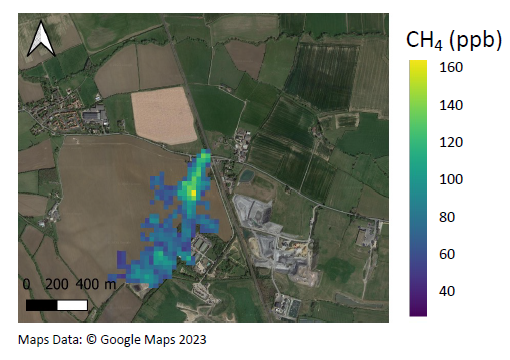NCEO and SENSE PhD student, Emily Dowd at the University of Leeds, has led the recently launched publication about the detection and validation of a major methane leak in the UK. The publication was released today in EGU – Atmospheric Measurement Techniques.
The study by Dowd et al. provides the first validation of the satellite-derived emission estimates using surface-based mobile greenhouse gas surveys of an active gas leak detected near Cheltenham, UK in spring and summer of 2023.
During the study period (March-June 2023), GHGSat estimated emission rates of 236–1357 kg CH4 h-1 which are in broad agreement with the surface based mobile survey estimates of 634–846 kg CH4 h−1. The team also used a Lagrangian transport model, the UK Met Office’s Numerical Atmospheric-dispersion Modelling Environment (NAME), to estimate the flux from both satellite- and ground-based observation methods and assess the leak’s contribution to observed concentrations at a local tall tower site (30 km away). The modelled flux estimated in NAME 181–1243 kg CH4 h-1, which are lower than the satellite- and mobile-survey-derived fluxes but are within the uncertainty. The team also demonstrate, using NAME, that it is unlikely that the nearby tall tower observations can be used to alert us to a gas leak of this size, location and duration.
“The detection, quantification and mitigation of this large UK gas leak emphasises the importance of validating high-resolution satellites, such as GHGSat, because they are increasingly powerful tools in helping to reduce the human impact on climate change” – Emily Dowd.
In addition to monitoring the gas leak, GHGSat took steps to notify the utility company of the leak which led to mitigation. Over the 11 weeks, it was estimated that the total methane leaked is equivalent to the emissions from the annual electricity consumption of approximately 7500 homes.
This study highlights the importance validating high resolution satellite data and the use of multiscale measurement methods to reduce the human impact on climate change.
You can access the full publication here: https://amt.copernicus.org/articles/17/1599/2024/
